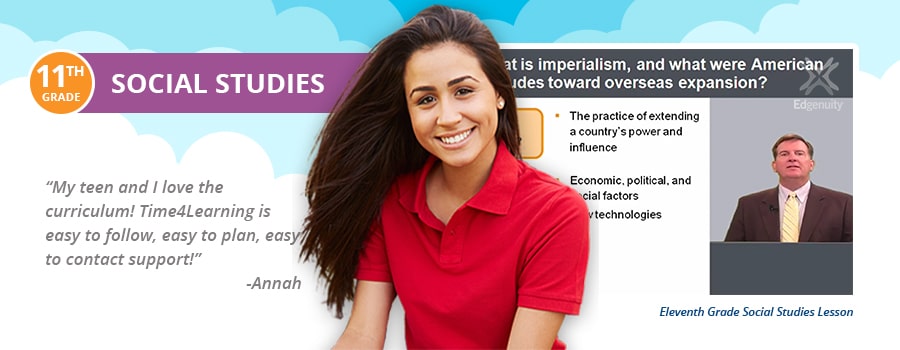11th Grade Social Studies Curriculum
In 11th grade social studies, students are usually taught U.S. History II or World History (depending on preference, state requirements and academic level). Junior high school students are expected to get a deep understanding of major events and turning points throughout history, as well as advanced knowledge in geography and culture.
Learn more about what juniors are expected to learn throughout the year, the objectives you should be setting, and how Time4Learning’s 11th grade social studies curriculum can be your ideal choice.
What Do You Teach in 11th Grade Social Studies?
The typical high school social studies sequence generally moves from World History and Geography to US History to Participation in Government/Civics or Economics. Different states, homeschoolers and schools may vary in their sequence.
With Time4Learning, parents have four choices at the high school level to set as their preferred course for their 11th grade social studies curriculum.
Once you’ve chosen the social studies curriculum you wish your 11th grader to learn, you should ensure students get a thorough understanding of the different eras in US or World History. Students should also learn to examine and question the reliability of historical evidence and make conclusions about history.
If you follow Time4Learning’s recommendation of teaching U.S. History II in 11th grade you can expect to see the topics below in the curriculum:
- Industrialization, the Gilded Age, immigration, and urbanization
- Populism and the American West
- Progressivism and Reform
- Imperialism and World War I
- The 1920’s and the Great Depression
- World War II and the Cold War
- The Era of Cultural Change
- The ‘70s and ‘80s to the modern world
Learn more about Time4Learning’s eleventh grade social studies curriculum below.
Social Studies Objectives for Eleventh Grade
As you plan for a successful completion of 11th grade social studies, you will want to make sure that your 11th grade social studies lesson plans meet the goals and objectives you have set for your child.
Here are some examples of the types of learning goals and objectives that your child should achieve in 11th grade:
- Analyze legal documents, essays, historical writings, and political cartoons.
- Craft informative and argumentative essays regarding important historical events.
- Draw connections between the past and present, between cultures, and between differing perspectives.
- Provide examples of important leaders who left their marks.
- Accurately place major events in chronological order and explain historical causation, continuity and change over time.
- Compare and contrast different sets of ideas, events and people.
- Explain how some historical developments connect to broader historical processes across regions and time.
- Evaluate diverse historical perspectives and how they influenced historical interpretation over time.
- Understand what makes some historical interpretations better than others.
- Understand the impact of conflicts and cooperation on societies.
Time4Learning’s 11th Grade Social Studies Scope & Sequence
- A New Revolution
- New American Industries
- Trusts and Big Business
- Technology and Society in the Industrial Age
- A Worker’s Life
- Labor Unions
- Strikes and Unrest
- Socialism and Workers’ Parties
- Reforming Business
- Coming to America
- New Waves of Immigration
- The Immigrant Experience
- The Growth of Cities
- Living and Working in Cities
- Urban and Social Reforms
- Political Machines
- Reforming Government
- Writing Workshop: Summarizing Historical Trends
- Going West
- The Transcontinental Railroad
- Homesteaders
- Expansion and American Indians
- Indian Wars
- Farmers on a Closing Frontier
- The Populist Party
- Early Progressivism
- The Muckrakers
- Women’s Rights and Suffrage
- Segregation and Accommodation
- Early Civil Rights Movements
- Roosevelt’s Square Deal
- Taft’s Reforms
- Wilson’s New Freedom
- The New Frontier
- Expanding Borders
- The Spanish-American War
- Panama and Latin America
- Neutrality and the War in Europe
- American Involvement in the War
- A New Kind of Warfare
- Freedom of Speech and the War
- Wilson and the War
- Prohibition
- Society in the 1920s
- The Great Migration
- A Roaring Economy
- Boom and Bust
- Effects of the Great Depression
- The Dust Bowl and the American Farmer
- Roosevelt’s Hundred Days
- The Second New Deal
- Opposition to the New Deal
- Cumulative Exam
- Fascism and Aggression
- America’s Entry into the War
- Mobilization on the Home Front
- Americans at War
- Internment and the Constitution
- A War on Many Fronts
- Turning Points in Europe
- Turning Points in the Pacific
- End of the War in Europe
- End of the War in the Pacific
- War Crimes and the Holocaust
- Writing Workshop: Creating an Argumentative Essay
- An Iron Curtain
- Treaties and Blocs
- Truman’s Fair Deal
- The Korean War
- The Baby Boom
- McCarthyism
- The Arms Race and the Space Race
- Brinkmanship and Vietnam
- Early Civil Rights Efforts
- Equal Education
- Organizing to Demand Rights
- Nonviolent Protest
- Civil Rights and Voting Rights
- Other Perspectives on Civil Rights
- Extending Civil Rights
- The Cold War and Cuba
- Kennedy and a New Frontier
- Expansion of the Vietnam War
- The Counterculture
- Johnson’s Great Society
- The Warren Court
- Changing Immigration
- A Political Turning Point
- Fall of Vietnam
- Nixon’s Presidency
- Watergate and the Ford Years
- The Economy in the 1970s
- Carter and the Middle East
- Women’s Rights Movement
- Reagan and the 1980s
- Reagan and the Evil Empire
- The End of the Cold War
- The Bush Presidency
- The Clinton Administration
- Partisan Conflict in Government
- September 11, 2001
- America in the Bush Years
- Military Intervention in the Middle East
- The Obama Presidency
- Immigration and Demographic Change
- America and the Global Economy
- Technology and its Effects on Modern America
- Cumulative Exam
Why Choose Time4Learning Eleventh Grade Social Studies Homeschool Curriculum?
11th graders typically study U.S. History II for social studies, however, with Time4Learning parents and students can choose to customize their course choices based on skill level, interests, and overall high school plans.
As juniors explore their post-high school options, your child will get a clearer understanding of the patterns, processes, and people that have shaped our history. The topics presented across our high school social studies courses will help students draw connections between the past and present, between cultures and places, as well as multiple perspectives.
As a social studies homeschool curriculum for 11th grade students, Time4Learning provides all the coursework for a full year. Parents get access to four different courses (of their choice) for a low monthly fee of $34.95, and each additional course costs $5. Our program can also be used to supplement traditional schooling or other curricula.







